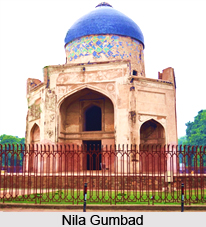 Fifty yards outside the eastern wall of the enclosure of Humayun`s mausoleum, on the south-eastern side is an impressive tomb of plastered stone covered with a blue dome commonly called the Nila Gumbad (Blue Dome). Unfortunately this monument is virtually inaccessible, as it has been encroached upon by families who live within its precincts. Sayyid Ahmad Khan, in Asarus-Sanadid believed that it contained the remains of Fahim Khan, a faithful attendant of Abdur Rahim Khan who died in 1626 during the reign of Emperor Jahangir.
Fifty yards outside the eastern wall of the enclosure of Humayun`s mausoleum, on the south-eastern side is an impressive tomb of plastered stone covered with a blue dome commonly called the Nila Gumbad (Blue Dome). Unfortunately this monument is virtually inaccessible, as it has been encroached upon by families who live within its precincts. Sayyid Ahmad Khan, in Asarus-Sanadid believed that it contained the remains of Fahim Khan, a faithful attendant of Abdur Rahim Khan who died in 1626 during the reign of Emperor Jahangir.
The building probably existed even before Tomb of Humayun. Based on the fact that the outer face of the enclosure-wall of Humayun`s Tomb, immediately opposite the Nila Gumbad, contains recessed arches which contrast with the plain construction of the wall everywhere else on this side; it also contains a doorway leading to the Nila Gumbad, it has been conjectured that the dome existed even before the mausoleum or was simultaneously designed with the enclosure-wall. It cannot therefore have been erected to enshrine the remains of a nobleman in Jahangir`s court.
The building is mainly built of local grey quartzite and is plastered both internally and externally. The dome is covered with dark blue tiles, and there are blue and yellow tiles round the drum. The tomb, octagonal on plan, stands on a platform 33.2 metres square and 1.5 metres high. The dome is raised on a high circular drum, and is crowned externally by an inverted lotus with a red sandstone finial. Inside it is carried on squinches with plastered interface and has a circular central panel profusely decorated with painted and incised plaster in Persian style. There is no monument over the grave. Externally the sides of the octagon contain four-centred recessed arches, of which those in the cardinal sides are pierced by square-headed doorways surmounted by four-centred and pierced tympana. The parapet is simple and without the usual pinnacles at the corners.
This article is a stub. You can enrich by adding more information to it. Send your Write Up to content@indianetzone.com



















